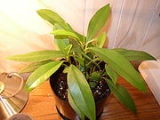
Ardisia humilis
Encyclopedia
Ardisia humilis is a species of Ardisia
in the family Myrsinaceae
, native to southeastern Asia
in southern China
(Guangdong
, Hainan
), the Philippines
, and Vietnam
.
It is an evergreen
shrub
growing to 1–2 m (rarely to 5 m) tall. The leaves
are broad ovate to elliptical, 15–18 cm long and 5–7 cm broad, with a leathery texture and an acute apex. The flower
s are reddish purple to pink, 5–6 mm diameter; they are produced in corymbs in mid spring. The fruit
is a red to dark purple drupe
6 mm diameter, containing a single seed
, mature in the late autumn.
Ardisia
Ardisia is a genus of flowering plants in the family Myrsinaceae , native to warm temperate to tropical regions of the Americas, Asia, and Australasia...
in the family Myrsinaceae
Myrsinaceae
Myrsinaceae, or the Myrsine family, is a rather large family from the order Ericales. It consists of 35 genera and about 1000 species....
, native to southeastern Asia
Asia
Asia is the world's largest and most populous continent, located primarily in the eastern and northern hemispheres. It covers 8.7% of the Earth's total surface area and with approximately 3.879 billion people, it hosts 60% of the world's current human population...
in southern China
China
Chinese civilization may refer to:* China for more general discussion of the country.* Chinese culture* Greater China, the transnational community of ethnic Chinese.* History of China* Sinosphere, the area historically affected by Chinese culture...
(Guangdong
Guangdong
Guangdong is a province on the South China Sea coast of the People's Republic of China. The province was previously often written with the alternative English name Kwangtung Province...
, Hainan
Hainan
Hainan is the smallest province of the People's Republic of China . Although the province comprises some two hundred islands scattered among three archipelagos off the southern coast, of its land mass is Hainan Island , from which the province takes its name...
), the Philippines
Philippines
The Philippines , officially known as the Republic of the Philippines , is a country in Southeast Asia in the western Pacific Ocean. To its north across the Luzon Strait lies Taiwan. West across the South China Sea sits Vietnam...
, and Vietnam
Vietnam
Vietnam – sometimes spelled Viet Nam , officially the Socialist Republic of Vietnam – is the easternmost country on the Indochina Peninsula in Southeast Asia. It is bordered by China to the north, Laos to the northwest, Cambodia to the southwest, and the South China Sea –...
.
It is an evergreen
Evergreen
In botany, an evergreen plant is a plant that has leaves in all seasons. This contrasts with deciduous plants, which completely lose their foliage during the winter or dry season.There are many different kinds of evergreen plants, both trees and shrubs...
shrub
Shrub
A shrub or bush is distinguished from a tree by its multiple stems and shorter height, usually under 5–6 m tall. A large number of plants may become either shrubs or trees, depending on the growing conditions they experience...
growing to 1–2 m (rarely to 5 m) tall. The leaves
Leaf
A leaf is an organ of a vascular plant, as defined in botanical terms, and in particular in plant morphology. Foliage is a mass noun that refers to leaves as a feature of plants....
are broad ovate to elliptical, 15–18 cm long and 5–7 cm broad, with a leathery texture and an acute apex. The flower
Flower
A flower, sometimes known as a bloom or blossom, is the reproductive structure found in flowering plants . The biological function of a flower is to effect reproduction, usually by providing a mechanism for the union of sperm with eggs...
s are reddish purple to pink, 5–6 mm diameter; they are produced in corymbs in mid spring. The fruit
Fruit
In broad terms, a fruit is a structure of a plant that contains its seeds.The term has different meanings dependent on context. In non-technical usage, such as food preparation, fruit normally means the fleshy seed-associated structures of certain plants that are sweet and edible in the raw state,...
is a red to dark purple drupe
Drupe
In botany, a drupe is a fruit in which an outer fleshy part surrounds a shell of hardened endocarp with a seed inside. These fruits develop from a single carpel, and mostly from flowers with superior ovaries...
6 mm diameter, containing a single seed
Seed
A seed is a small embryonic plant enclosed in a covering called the seed coat, usually with some stored food. It is the product of the ripened ovule of gymnosperm and angiosperm plants which occurs after fertilization and some growth within the mother plant...
, mature in the late autumn.

